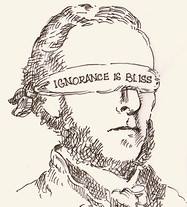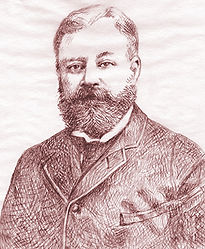
Who Killed President James Garfield? from “The Strange Fates of Robert Todd Lincoln”
It was July 2, 1881 at the crowded Baltimore and Potomac Railroad Station in Washington, D.C. The new President, James A. Garfield was waiting for the train to take him to New England. Secretary of War, Robert Todd Lincoln arrived at the lobby when he saw a man fire two bullets at the President who would be mortally wounded. The shooter, Charles Guiteau, was a mentally imbalanced, disgruntled office seeker who believed he was acting as an “instrument of God.”
Robert, the only surviving son of the assassinated President Abraham Lincoln, ordered soldiers to secure the area and asked for the doctor who he thought attended his dying father. In fact, Dr. Doctor Willard Bliss (yes, first name Doctor), was an arrogant quack who was pushed aside by President Lincoln's doctor. Now, Bliss stubbornly secured his place as Garfield's lead physician.
Garfield suffered an agonizing 80 days while Bliss and his team prodded the wound with dirty fingers. Bliss also refused to correctly use Alexander Graham Bell’s newly invented metal detector, the Induction Balance, even after Bell reported that the metal bed upon which the patient lay was interfering with the device’s signals.
The assassin, Guiteau, claimed in his defense that it was the doctors who killed Garfield. He was convicted and within weeks, hung.
James Garfield’s is the quintessential American rag-to-riches story. His superior intelligence and voracious appetite for learning propelled him out of the most impoverished childhood of all the presidents.
When he was 16, his widowed mother, convinced he was destined for greatness, spent her life’s savings of $17 for his college. Garfield was on a meteoric rise while juggling odd jobs to pay for his studies. He was a professor at age 18; president of Hiram College in Ohio at age 26; then, a successful lawyer. At age 30, while a Union general in the Civil War, he was re-elected to the Ohio House of Representatives. His nominating speech for the slated presidential candidate at the Republican convention was so powerful, the votes unexpectedly switched to him. Garfield was 49 years old when elected President, November 19, 1831.
A radical thinker and resolute abolitionist, he championed public education for all, including African Americans. He appointed their leaders, including Frederick Douglass, to prominent positions. In his Inaugural Address, Garfield emphasized, “It is the high privilege and sacred duty of those now living to educate their successors, and fit them, by intelligence and virtue for the inheritance which awaits them.”
It is tragic that this message went unheeded, “Nobody but radicals have ever accomplished anything in a great crisis.” The radicals Alexander Graham Bell and Dr. Joseph Lister were ignored by the doctors caring for the president. Their blind ignorance contributed to his death.
“Who Killed President James Garfield?” is my monument to the extraordinary man who would be celebrated as one of our greatest presidents if his life was not cut short on September 19, 1881.
The Strange Fates of Robert Todd Lincoln
“Who Killed President James Garfield?” is one diorama in “The Strange Fates of Robert Todd Lincoln”. Robert was associated with the assassinations of three American presidents. In April 1865, he attended the death bed of his father, Abraham Lincoln. In 1881, he witnessed the shooting of James Garfield. In 1901, he arrived at the train station in Buffalo, NY, moments after President William McKinley was shot at the Pan-American Exposition.

Dr. Doctor Willard Bliss
Susan Bercu, pencil
diorama detail

Induction Balance
Alexander Graham Bell, sketch
Susan Bercu, Ink copy
“Who Killed President James Garfield? ”
from “The Strange Fates of Robert Todd Lincoln”
Diorama 21 in. wide x 17 in. high x 11.5 in. deep

Charles Guiteau's English Bulldog Pistol used to shoot President James Garfield
Susan Bercu, acrylic painting
Charles Guiteau, the Assassin
Charles Guiteau did not receive the adulation he expected. The ivory-handled pistol that he bought because "it would look good in a museum", was lost by the Smithsonian. He even had his shoes shined so he would shine when everyone lauded him as a hero. (They didn’t.)
Copies of a poster of the “Phrenological Delineation of the Character of Charles Guiteau”, were distributed after the assassination at 10 cents each. Phrenology, a pseudo-science popularized in the mid-19th century, mapped human traits inferred from the shape of the skull. Guiteau’s chart included 40 traits, some with quaint names as, amativeness and approbativeness. However, Assassination, didn’t make the cut.
He was thrown into prison where he reveled in the media sensation he caused. Although mentally deranged, Guiteau represented himself at the trial and argued that he had only wounded the president... it was the doctors who killed him. The defense didn’t spare him. He stood on the scaffolding reciting his poem “I’m going to the Lordy.” (It was set to music 110 years later in Stephen Sondheim’s “Assassins”.) Guiteau’s request for an orchestra was denied. (Tune was on his phrenology chart.)
Ignorance is Bliss
After an agonizing 80 days, President Garfield succumbed, leaving behind a doting wife and five children. If the bullet was left undisturbed, modern medical experts suggest that he might have lived.
Since Dr. Doctor Willard Bliss and his fellow physicians were staunch deniers of the sterilization techniques advocated by Dr. Joseph Lister (for whom Listerine was named), they used their dirty fingers to repeatedly probe for the bullet in their patient. The result was a raging infection but no bullet.
Alexander Graham Bell submitted his newly invented metal detector, the Induction Balance, for the search. It worked flawlessly in tests but failed to locate the bullet. When Bell realized that the bed’s metal springs were interfering with the device, he informed the doctor. Bliss refused to move his patient even when Bell argued that only one side of Garfield’s body was being examined.
Bonus Strange Fact
Robert Lincoln, who was 40 feet from the shooting and saw it clearly, was not asked to testify at the trial of Charles Guiteau. It is thought that the prosecutor wanted to spare Robert because of his father’s assassination.
Robert Todd Lincoln Susan Bercu, pencil

